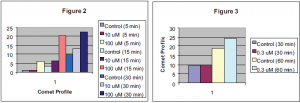Jeremy McBride and Dr. Kim L. O’Neill, Microbiology
Epigallocatechin gallate (EGCG) is a polyphenol found in green tea. Because tea is ingested by over two thirds of the world’s population, considerable research has been done to identify and characterize the active components of the second most widely consumed beverage (1). Among the many chemopreventative properties that have been attributed to green tea, and EGCG, this botanical product has been established as an antimutagen and a potent free-radical scavenger that has been shown to effectively quench reactive oxygen and nitrogen species that may otherwise damage DNA and other sensitive biomolecules. Such damage, accumulated over time, may lead to mutagenesis and the development of degenerative diseases, such as cancer.
Despite the many studies that have been done on EGCG, relatively little has been done to show its effect on DNA and DNA repair rate. However, previous research has shown that EGCG directly inhibits DNA polymerase activity, suggesting a depressed DNA repair rate (2). EGCG has also been suggested as a possible DNA damaging agent. In this study I sought to first evaluate the effect of EGCG on DNA repair and then, due to unexpected data, investigate EGCG as a possible DNA damaging agent.
To investigate the effect of EGCG on DNA repair, cells were pre-incubated for 1 hour in media impregnated with 10 μM EGCG. After the timed incubation, cells were exposed to a lethal dose of 10 greys of gamma radiation and returned to the incubator. The cells were counted every 3 hours thereafter and their viability assessed using the trypan blue exclusion assay. A death curve was then plotted comparing the viabilities of the unradiated cells, to the radiated and the radiated EGCG treated cells (data not shown). Both radiated populations exhibited a dramatic decrease in viability beginning at 15 hours, but did not show any significant difference in viability after 24 hours. Further investigations must be conducted to conclusively show an enhancement or inhibition of DNA repair and repair rate.
To elucidate whether or not the DNA was being damaged directly by EGCG, we first confirmed the antioxidative activity of EGCG on cells pre-incubated with EGCG. The assay revealed DNA protection from oxidative damage at low concentrations, 10 μM, and allow or cause increasingly more damage at higher concentrations, 25 and 50 μM (data not shown). This data was collected employing the Alkaline Comet Assay. Briefly, the Alkaline comet assay consists of seven steps: 1) cells are suspended in agarose on a microscope slide, 2) the cells are treated/damaged, 3) cell lysis, 4) DNA unwinding, 5) electrophoresis, 6) staining and 7) data collection with fluorescent microscopy and software analysis. This effectively allows us to determine DNA damage done to a population of cells, by quantifying the migration of DNA fragments in representative nucleoids.
After an analysis the trend represented in the protection assay, described above, I decided to determine if EGCG was damaging DNA directly or indirectly, through a cellular pathway. To do so, the standard comet procedure was followed with a minor modification: cells were lysed before treatment/damage to allow the EGCG to interact with naked DNA and exclude all indirect damaging pathways. I found EGCG to damage DNA in a dose dependant manner as concentration of EGCG increased (fig. 1).
Given the widespread use and acceptance of green tea as an antioxidant and antimutagen, I decided to investigate whether or not my findings were applicable to the physiological concentration of EGCG found in blood serum levels. I found a recent publication that determined serum levels of EGCG as high as 140ng/ml (0.309 μM) after the ingestion of 5 grams of green tea (4). It also reported that EGCG was detectable in the serum for up to 6 hours after ingestion. With this in mind we repeated the modified Alkaline Comet assay on naked DNA with a 0.309 μM concentration of EGCG. We found that a 60 min treatment caused significant DNA damage (fig. 2).
The data I have collected shows a potential paradox in the characteristics of green tea: it protects DNA from oxidative damage and other mutagens, yet it damages DNA directly and may inhibit DNA repair, all at physiological concentrations. In order to conclusively determine if the damage caused by EGCG is physiologically significant, it would be necessary to pursue further investigations in a tightly regulated in vivo system. Perhaps the benefits of EGCG negate the reported potential drawbacks. Only further investigation can tell.
References
- Kuroda, Y., Hara, Y. 1999. Antimutagenic and anticarcinogenic activity of tea polyphenols. Mutation Research 436:69-97.
- Achiwa, Y., et al. 1997. Inhibitory effects of persimmon (Diospyros kaki) Extract and related polyphenol compounds on growth of human lyphoid leukemia cells. Biosci. Biotech. Biochem. 61:1099-1101.
- Johnson, M. K., Loo, G. 2000. Effects of epigallocatechin gallate on oxidative damage to cellular DNA. Mutation Research 459:211-218.
- Unno, T. et al. 1996. Analysis of (-)-epigallocatechin gallate in human obtained after ingesting green tea. Biosci. Biotech. Biochem. 60:2066-2068.

